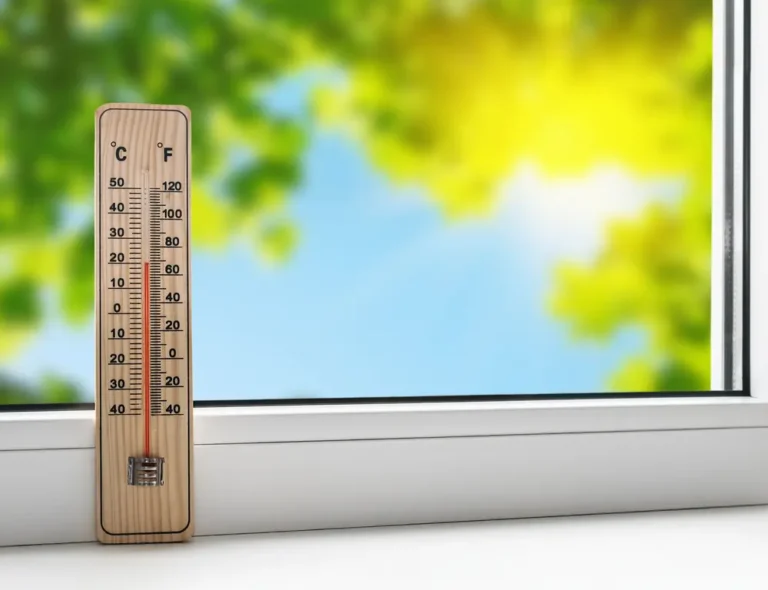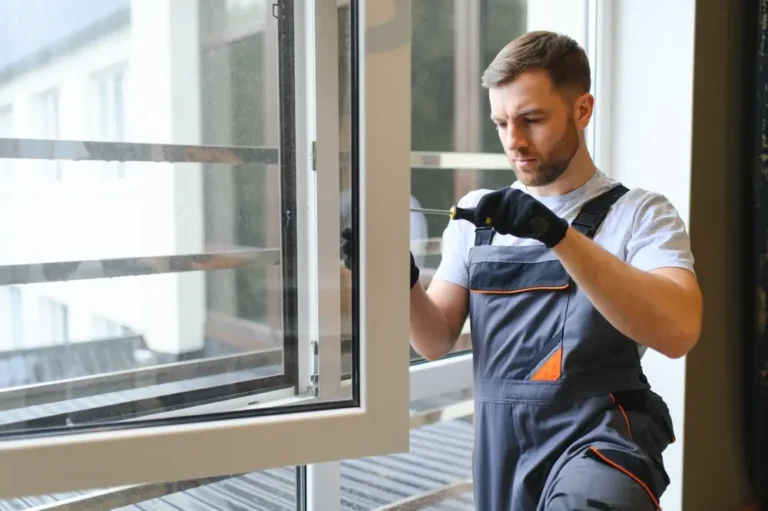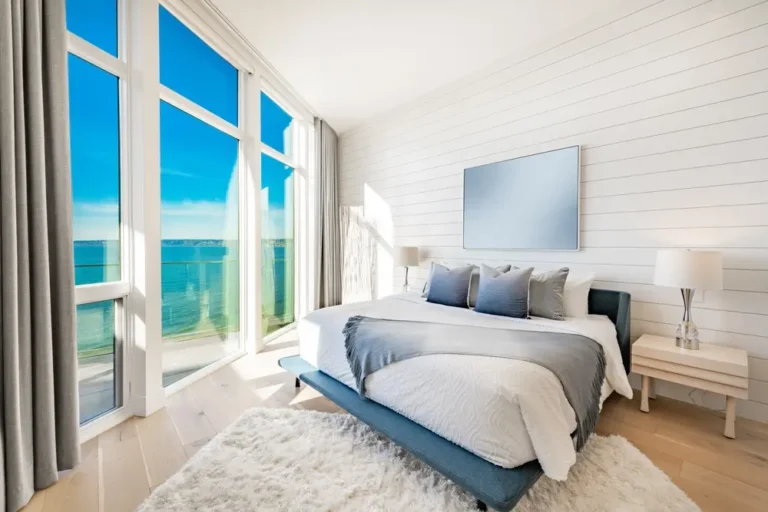European Windows vs American Windows
When it comes to pushing boundaries in innovation, the U.S. excels in many fields. However, when it comes to windows, Europe has set a benchmark for energy efficiency and design. This is largely due to stricter energy efficiency standards across Europe, which have driven advancements in materials, insulation, and functionality.
European windows are synonymous with tilt-and-turn mechanisms and often feature innovative multi-chamber profiles. These windows prioritize both performance and durability which makes them a compelling option for modern homes, combining sleek aesthetics with impressive energy savings.
In this article, we’ll explore the unique features of European windows and why they’re gaining popularity in the U.S. market.
Key Differences Between European Windows vs American Windows
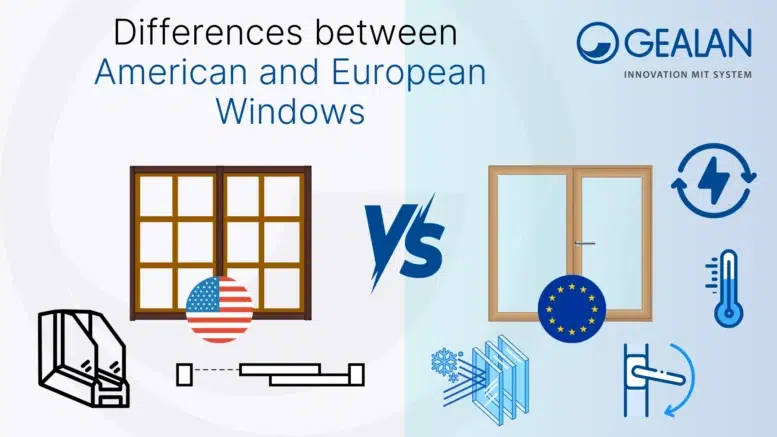
While American and European windows may look similar at a glance, their underlying design philosophies and technical features reveal distinct differences.
American Windows: Simplicity and Familiarity
American windows prioritize convenience and are often designed with functionality in mind. Popular styles include:
- Double-Hung: Features two sashes that slide vertically, offering a classic look.
- Single-Hung: Similar to double-hung but with only one movable sash.
- Sliding Windows: Open horizontally or vertically along a track for ease of use.
These designs are straightforward, easy to operate, and widely used across American homes.
European Windows: Efficiency and Versatility
European windows focus on energy performance, security, and adaptability. They often feature:
- Multi-Point Locking Systems: Enhanced security and a tight seal for energy efficiency.
- Tilt-and-Turn Mechanisms: Flexible opening options for ventilation and cleaning.
- Thicker Frames: Improved insulation and durability.
This emphasis on innovation results in windows that outperform American styles in insulation, security, and overall functionality.
Material Choices
Material selection plays a significant role in both the durability and aesthetics of windows. Both Americans and Europeans favor vinyl window profiles most, as they are affordable, efficient and durable.
In Europe, vinyl frames are referred to as uPVC (unplasticized polyvinyl chloride) frames. While vinyl is perceived as a “cheap” material, its cost effectiveness should not come as a sign of low quality. Premium uPVC window frames can outperform aluminum and fiberglass in many ways and are:
- Rigid and Durable: Resistant to warping, fading, and cracking.
- Energy Efficient: Offer superior insulation, reducing energy costs.
- Low Maintenance: Require minimal upkeep and resist wear over time.
The insulation properties of uPVC windows also make them amazing for noise reduction, further enhancing comfort in homes.
Window Styles: Tilt-and-Turn vs. Double-Hung
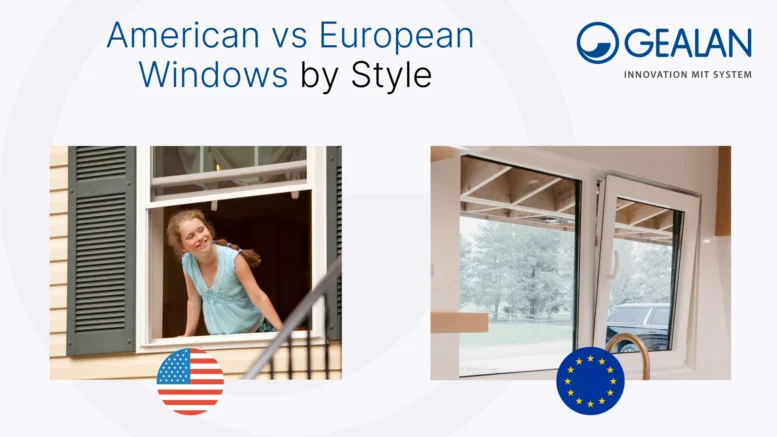
One of the most noticeable differences between American and European windows is the style. Each region has distinct preferences that suit specific needs and architectural norms.
Double-Hung Windows
A hallmark of American design, double-hung windows feature two vertically sliding sashes. They are:
- Timeless in Aesthetic: A classic choice for traditional and transitional homes.
- Easy to Clean: Sashes tilt inward for simple maintenance.
While iconic, double-hung windows may not provide the energy efficiency or flexibility found in modern European designs.
Tilt-and-Turn Windows
Tilt-and-turn windows redefine versatility with their smart dual functionality:
- Ventilation Made Simple: Tilt inward for a gentle breeze without sacrificing security.
- Full Access: Swing open like a door for effortless cleaning and fresh air.
- Smart Design: Combines sleek style with superior energy efficiency to keep your home comfortable year-round.
Loved for their modern look and practicality, tilt-and-turn windows bring European innovation to homes everywhere.
Energy Efficiency Standards

Energy efficiency is a key consideration for homeowners, and American and European windows take different approaches to meet this need. Their designs reflect regional regulations, climate demands, and priorities, but both aim to improve comfort and reduce energy consumption.
Stringent Energy Efficiency Standards in Europe
Europe takes energy efficiency seriously, and it shows in the windows designed there. Many meet the demanding Passive House certification, making them some of the most energy-efficient windows in the world. Triple glazing—or triple-pane construction—is standard, working to drastically cut heat transfer. This means cozy warmth in the winter and a cooler, more comfortable home in the summer.
Thicker frames add to this efficiency, blocking drafts and ensuring a strong, insulated fit. Multi-point locking systems don’t just enhance security—they also create a tighter seal to keep energy from escaping. Low-E glass completes the package, reflecting heat and reducing energy use while still letting in natural light.
American Energy Efficiency: Energy Star Standards
Most American windows feature double-pane glass, which, while an improvement over single-pane designs, is less effective at insulation compared to Europe’s standard triple glazing. This allows more heat to escape in winter and enter during summer, leading to higher energy consumption.
American frames are also typically thinner, which maximizes glass area but sacrifices insulation. Weather sealing often relies on basic brush weatherstripping, which may degrade over time and allow drafts to develop. While low-E coatings are commonly applied to improve thermal performance, the overall efficiency often falls short of what’s achievable with European designs.
Glass Types: Double Pane vs. Triple Pane
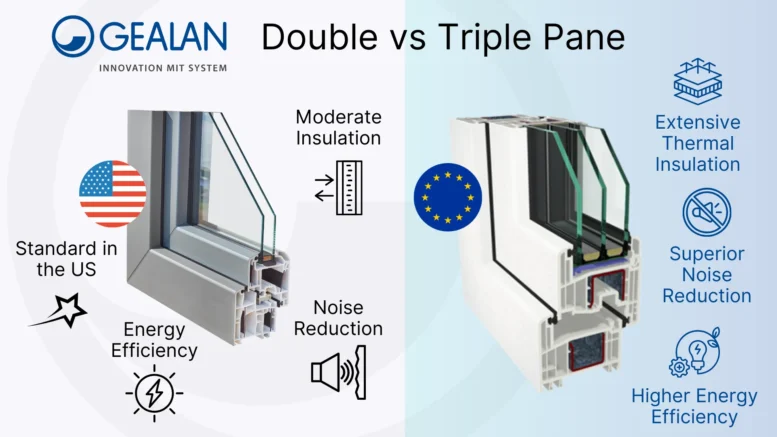
The glass you choose makes a big difference in how well your windows perform, especially when it comes to energy efficiency.
Double Pane
Double-pane windows are a staple in American homes, offering reliable insulation without a hefty price tag. They feature two layers of glass with insulating gas, like argon, in between. This setup helps reduce energy transfer, keeping homes comfortable in most climates. However, they can fall short in regions with extreme temperatures, where stronger insulation is needed.
Triple Pane Windows
Triple-pane windows are the gold standard in Europe for a reason. With three layers of glass and advanced coatings, they offer top-tier insulation and significantly reduce heat transfer. These windows are especially beneficial in colder climates, keeping warmth inside while lowering energy costs. Though they come with a higher upfront cost, the long-term savings make them a smart investment for energy-conscious homeowners.
Locking Mechanisms and Security
Window security plays a critical role in protecting your home and improving energy efficiency. American and European windows differ significantly in their approach to locking mechanisms.
Multi-Point Locking Systems in European Windows
European windows are known for their multi-point locking systems, which secure the window frame at multiple points. This design significantly enhances security, making it harder for intruders to force the window open. Beyond safety, these locks also contribute to energy efficiency by ensuring a tighter seal, preventing drafts, and reducing heat loss.
Single Lock Systems in American Windows
American windows typically use single-lock mechanisms, particularly in double-hung and sliding styles. While functional and easy to use, these locks don’t offer the same level of security or sealing power as multi-point systems.
Aesthetics and Design Styles
Both American and European windows offer distinct aesthetic appeals that can influence the look of a home.
Traditional American Aesthetics
American windows emphasize classic design elements, such as divided panes and traditional frame styles. Popular options like double-hung and sliding windows deliver a timeless look that works well with a variety of architectural designs, from colonial to craftsman.
Minimalist European Design
In Europe, minimalist and modern design trends dominate. European windows often feature clean lines, sleek hardware, and large glass panes, maximizing natural light and creating an open, airy feel. This European style is ideal for contemporary homes that prioritize minimalism and functionality.
Installation
Installation processes for American and European windows differ due to variations in design and functionality.
Installing American Windows
American windows, especially double-hung and sliding windows, are generally easier to install due to standardized sizes and simpler locking mechanisms. Installation is typically more affordable and quicker than with European models, though proper sealing and weatherproofing remain essential for energy efficiency.
Installing European Windows
European windows, with features like tilt-and-turn functionality and multi-point locking systems, require precise installation to ensure optimal performance. Specialized installers are often needed to handle the unique designs and ensure that the windows deliver their promised thermal efficiency and durability.
Durability and Longevity
The lifespan of a window depends on the materials used, the design, and how well it’s maintained over time.
American Vinyl Windows
Vinyl is a popular material for American windows due to its low maintenance and resistance to weathering. While durable, vinyl windows may have a shorter lifespan than some European alternatives, particularly in extreme climates where they can warp or fade over time.
European uPVC Windows
European uPVC windows are built to last. These windows resist warping, cracking, and fading, even in harsh weather conditions. Their durability, combined with minimal maintenance needs, makes them an increasingly popular choice for homeowners seeking long-term value.
Which Windows Are Right for Your Home?
Choosing between American and European windows depends on your preferences and priorities.
- If energy efficiency and modern aesthetics matter most, European windows with triple glazing and tilt-and-turn functionality are an excellent choice.
- If you value affordability and traditional design, American double-pane windows might be the better fit.
Assess your home’s climate, style, and budget to determine which option aligns best with your needs.
Make the Right Choice for Your Home’s Windows
Both American and European windows have their strengths. While American windows often provide accessibility and affordability, European models excel in energy efficiency, durability, and advanced features like tilt-and-turn functionality.
For those ready to invest in high-performance, energy-efficient windows, GEALAN’s European window systems offer innovative designs tailored to meet stringent energy and durability standards. With options like the GEALAN-LINEAR and S 8000, we deliver energy-efficient solutions for any architectural style. Connect with GEALAN to see if there is a trusted local dealer near you.
Table of Contents
FAQs
Why are European windows considered more energy-efficient?
European windows feature triple glazing, multi-point locking systems, and thicker frames, all of which reduce heat transfer and improve insulation—perfect for cold-weather climates.
What are tilt-and-turn windows?
Tilt-and-turn windows offer dual functionality: tilt inward from the top for ventilation or fully swing open for easy cleaning and added security.
Can I install European windows in an American home?
Yes, European windows can be installed in American homes, though they may require specialized installation due to their unique features and sizes. Contact a local dealer to find out more.
